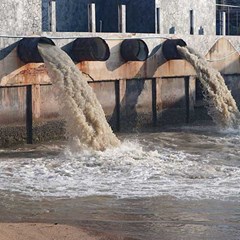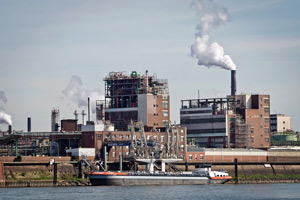Industrial Waste Water Treatment-- Eco-Friendly Solutions for Water Recycling
Industrial Waste Water Treatment-- Eco-Friendly Solutions for Water Recycling
Blog Article
Advancements and Breakthroughs in Industrial Waste Water Therapy Technologies
The landscape of industrial wastewater treatment is undergoing a transformative shift, driven by technologies that improve both effectiveness and sustainability. Emerging technologies, such as membrane layer bioreactors and microbial gas cells, are redefining contaminant removal procedures while adding to energy generation. Furthermore, resource recuperation methods are gaining traction, lining up with round economic situation principles. As regulatory criteria develop, the integration of AI and maker understanding right into wastewater administration systems promises to enhance operations and guarantee conformity. However, the complete implications of these innovations elevate important concerns about their scalability and long-lasting effect on sector techniques.
Introduction of Drainage Treatment Technologies
Wastewater treatment innovations encompass a variety of techniques created to eliminate pollutants from industrial effluents before their launch into the atmosphere. These technologies are essential for keeping ecological balance and ensuring conformity with environmental regulations. The key groups of wastewater therapy consist of physical, chemical, and biological techniques, each serving distinctive purposes based upon the nature of the impurities existing.

Biological therapy approaches use microorganisms to deteriorate natural matter, making them specifically effective for organic-rich effluents. Strategies like triggered sludge and biofilm reactors harness the natural deterioration abilities of germs, bring about considerable reductions in biochemical oxygen demand (BODY)
Advanced Filtration Strategies
Advanced purification strategies stand for a vital evolution in the world of industrial wastewater treatment, improving the efficiency of contaminant elimination procedures. Industrial Waste Water Treatment. These methods encompass a series of technologies, consisting of microfiltration, ultrafiltration, nanofiltration, and reverse osmosis, which give sequential obstacles for numerous fragment dimensions and chemical structures
Microfiltration and ultrafiltration utilize membrane layer systems to remove suspended solids, bacteria, and larger organic molecules, improving the quality of effluent previous to further therapy. Nanofiltration links the gap between ultrafiltration and reverse osmosis, properly getting rid of natural substances and divalent ions, hence minimizing the load on downstream procedures.
Reverse osmosis provides the highest degree of filtration by permitting only water and little particles to travel through its semi-permeable membrane layers, making it excellent for redeeming high-grade water from industrial effluents. Current advancements in membrane layer technology, including the development of even more fouling-resistant and sturdy materials, have actually significantly enhanced functional efficiency and reduced expenses.
Incorporating these advanced purification techniques not only boosts the general therapy procedure but additionally adds to sustainability initiatives by allowing water reuse and source healing in industrial setups. (Industrial Waste Water Treatment)
Biological Therapy Advancements

Moreover, the advancement of engineered biological systems, such as membrane layer bioreactors (MBRs), combines biological treatment with innovative membrane layer filtration. This assimilation enables for higher effluent high quality and minimized impact, making it suitable for space-constrained industrial facilities. Technologies in genetically crafted microorganisms have actually also emerged, improving the biodegradation of details pollutants, such as drugs and hefty steels, that are commonly testing to remove.
Additionally, the execution of bioaugmentation strategies, where helpful microbes are presented to improve the existing organic treatment procedures, has actually revealed promising cause improving therapy performance. These advancements jointly symbolize a trend towards even more efficient and sustainable biological see it here treatment methodologies that can adapt to the advancing complexities of commercial wastewater streams. As industries remain to focus on ecological conformity, these biological technologies will certainly play an important function in wastewater monitoring.

Resource Recovery Approaches
In industrial settings, the assimilation of resource recovery techniques has actually ended up being increasingly important for boosting sustainability and minimizing waste. These methods concentrate on drawing out valuable products and energy from wastewater streams, therefore changing prospective contaminants right into reusable sources.
One noticeable strategy is vitamins and mineral recovery, where nitrogen and phosphorus, typically present over in wastewater, are caught and exchanged fertilizers. This not only minimizes environmental impacts yet also supplies a circular economy remedy for agricultural applications. Additionally, innovations such as anaerobic food digestion enable the conversion of natural waste into biogas, a renewable energy source that can offset nonrenewable fuel source usage in industrial procedures.
Furthermore, progressed filtration and membrane modern technologies promote the recovery of commercial spin-offs such as salts and steels. These recouped products can be reintegrated into production procedures, decreasing the need for virgin sources.
Future Trends in Drainage Administration
As industries significantly focus on sustainability, the future of wastewater management is readied to undergo significant transformations. Technological developments, such as synthetic knowledge and artificial intelligence, will enable more reliable tracking and monitoring of wastewater systems. These technologies can predict maintenance requirements, maximize therapy procedures, and boost decision-making, inevitably minimizing functional prices and environmental influence.
Furthermore, the assimilation of circular economic climate concepts will certainly play a critical role in wastewater administration. Industries are anticipated to move in the direction of systems that not only treat wastewater but also recuperate beneficial sources, such as nutrients, water, and power. This shift will certainly decrease waste and advertise the reuse of materials, aligning with global sustainability goals.
Emerging treatment techniques, such as membrane layer bioreactors and advanced oxidation processes, will certainly even more enhance the effectiveness of wastewater therapy, enabling better effluents ideal for reuse. In addition, regulative structures are likely to evolve, emphasizing more stringent criteria for wastewater discharge and encouraging markets to embrace cutting-edge treatment remedies.
Final Thought
Finally, the development of industrial wastewater Get More Information therapy technologies shows a significant shift towards boosted performance and sustainability. Technologies in advanced filtering techniques, biological treatments, and resource recuperation techniques highlight the sector's dedication to environmental stewardship. The combination of fabricated intelligence and artificial intelligence better optimizes these processes, making sure regulative conformity and advertising a round economic situation. Proceeded innovations in these locations will certainly play a crucial duty in shaping the future of wastewater management and safeguarding important water resources.
The landscape of commercial wastewater treatment is undertaking a transformative shift, driven by technologies that boost both effectiveness and sustainability.Wastewater treatment technologies encompass an array of approaches designed to get rid of pollutants from commercial effluents prior to their launch right into the setting.Utilizing the power of biological processes has actually led to considerable technologies in the treatment of industrial wastewater.Furthermore, the execution of bioaugmentation approaches, where beneficial germs are presented to boost the existing biological therapy processes, has revealed encouraging results in boosting treatment efficiency. These innovations jointly signify a trend in the direction of even more sustainable and effective biological therapy approaches that can adapt to the evolving complexities of commercial Check This Out wastewater streams.
Report this page